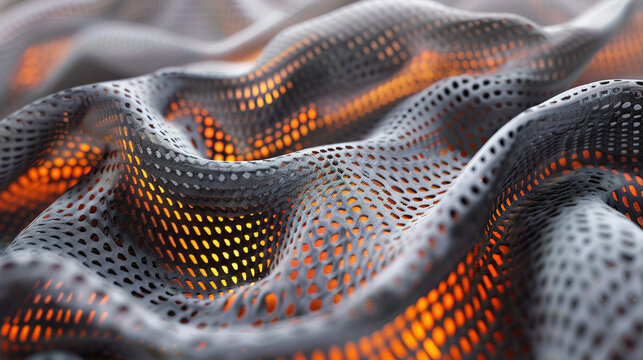The textile industry is no stranger to innovation, and one of the most exciting advancements in recent years is the development of nano-textiles. By incorporating nanotechnology into fabric production, manufacturers can create textiles with enhanced properties that were once unimaginable. This blog delves into the benefits and applications of nano-textiles, showcasing how this technology is revolutionizing the textile industry.
What are Nano-textiles?
Nano-textiles are fabrics engineered with nanotechnology, which involves manipulating materials at an atomic or molecular scale—typically less than 100 nanometers. By embedding nanoparticles or nanostructures into fabrics, these textiles acquire unique characteristics that enhance their functionality and performance.

Benefits of Nano-textiles
- Enhanced Durability
Nanotechnology can significantly increase the durability of textiles. By reinforcing fibers with nanoparticles, fabrics become more resistant to wear and tear, extending the lifespan of garments and reducing the need for frequent replacements. - Improved Water and Stain Resistance
One of the most popular applications of nano-textiles is in creating water-repellent and stain-resistant fabrics. Nanoparticles can form a protective layer on the surface of the fabric, preventing liquids and dirt from penetrating the fibers. This technology is particularly useful for outdoor gear, upholstery, and everyday clothing. - Antimicrobial Properties
Nano-textiles can be engineered to have antimicrobial properties, making them resistant to bacteria, fungi, and other pathogens. This is achieved by incorporating nanoparticles like silver or copper, which have natural antimicrobial effects. Such textiles are ideal for medical applications, sportswear, and activewear, where hygiene is crucial. - UV Protection
Fabrics treated with nanoparticles can offer enhanced UV protection, shielding the skin from harmful ultraviolet rays. This is particularly beneficial for outdoor clothing and accessories, helping to reduce the risk of skin damage and related health issues. - Enhanced Comfort and Breathability
Nanotechnology can improve the comfort and breathability of fabrics. By manipulating the structure of fibers at the nanoscale, manufacturers can create textiles that are lightweight, soft, and more breathable, providing a better wearing experience.
For more on how technology is transforming textiles, check out our blog on Technology in Textiles.

Applications of Nano-textiles
- Healthcare
Nano-textiles are making significant strides in the healthcare sector. Antimicrobial fabrics are used in hospital linens, surgical gowns, and wound dressings to prevent infections. Smart textiles with embedded sensors can monitor patients’ vital signs, providing real-time health data to medical professionals. - Sports and Activewear
The sports industry benefits greatly from nano-textiles. Moisture-wicking fabrics, enhanced with nanotechnology, keep athletes dry and comfortable. Antimicrobial properties reduce odor, and UV protection is essential for outdoor sportswear. - Military and Defense
Nano-textiles play a crucial role in military applications. Fabrics with enhanced durability, water resistance, and antimicrobial properties are used in uniforms, gear, and equipment. Additionally, smart textiles with embedded sensors can monitor soldiers’ health and environmental conditions. - Fashion and Everyday Wear
The fashion industry is also embracing nano-textiles. From stain-resistant clothing to garments with enhanced comfort and breathability, nanotechnology is helping designers create innovative, functional fashion. For insights on how digital technology impacts textile design, read The Impact of Digital Technology on Textile Design and Production. - Home Textiles
Nano-textiles are used in various home applications, including water-repellent and stain-resistant upholstery, antimicrobial bedding, and durable curtains. These innovations improve the functionality and longevity of home textiles. - Industrial and Technical Textiles
In industrial applications, nano-textiles are used for filtration, protective clothing, and composite materials. Nanotechnology enhances the performance of these textiles, making them more efficient and durable.
For more information on different types of fabrics and their uses, visit our blog on The Ultimate Guide to Clothing Material.
Challenges and Future Prospects
Despite the numerous benefits, nano-textiles also face challenges. The high cost of production and concerns about the environmental impact of nanoparticles are significant hurdles. However, ongoing research and development are addressing these issues, paving the way for more sustainable and cost-effective solutions.
Conclusion
Nano-textiles represent a significant leap forward in textile technology, offering enhanced properties and opening up new applications across various industries. As research progresses, we can expect even more innovative uses and improvements in the field of nano-textiles.
For high-quality fabrics and comprehensive sourcing solutions, visit locofast.com. Locofast is committed to providing cutting-edge textile solutions that meet the highest standards of quality and innovation. Explore their website to learn more about their products and services, and discover how Locofast can support your journey in the world of advanced textiles.
